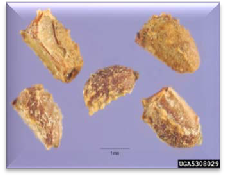Also Known As: Eurasian milfoil, spike/spiked watermilfoil
Eurasian Watermilfoil is a Class B Weed: Non-native species that are either absent from or limited in distribution in some portions of the state but very abundant in other areas. The goals are to contain the plants where they are already widespread and prevent their spread into new areas.
Eurasian watermilfoil (Myriophyllum spicatum L.), native to Eurasia and northern Africa, is an aggressive aquatic perennial with a trailing growth habit. This submersed, rooted plant has narrow stems that grow 10 feet or more in length and branch profusely near the surface of the water. Eurasian watermilfoil forms dense canopies of bright green, finely divided leaves that occur in whorls of 3 or 4. Each delicate, feather-like leaf is composed of 12–21 pairs of oppositely-arranged leaflets— more than that of the often-confused native Northern watermilfoil (Myriophyllum sibericum), which usually has less than 12 leaflet pairs per leaf. Eurasian watermilfoil produces small pinkish flowers (4- petalled or without petals) that occur on a reddish  spike protruding several inches above the water’s surface. The fruits of the plant are hard, segmented capsules containing 4 tiny seeds. Although the seeds are usually viable, germination is erratic. The primary method of reproduction for Eurasian watermilfoil is by stem fragmentation and runners. Not only is fragmentation caused by disturbance but is self-induced (autofragmentation ) after the plant bears fruit—once or twice in the summer. A single segment of stem and leaves can take root and form a new colony. Dispersal of Eurasian watermilfoil is heavily attributed to boating activity—stem fragments cling to watercraft apparatus, spreading the plant from water body to water body.
spike protruding several inches above the water’s surface. The fruits of the plant are hard, segmented capsules containing 4 tiny seeds. Although the seeds are usually viable, germination is erratic. The primary method of reproduction for Eurasian watermilfoil is by stem fragmentation and runners. Not only is fragmentation caused by disturbance but is self-induced (autofragmentation ) after the plant bears fruit—once or twice in the summer. A single segment of stem and leaves can take root and form a new colony. Dispersal of Eurasian watermilfoil is heavily attributed to boating activity—stem fragments cling to watercraft apparatus, spreading the plant from water body to water body.
Eurasian watermilfoil is the most disruptive water weed in the continental U.S. Once established, it forms dense mats that clog waterways and displace native aquatic species. This leads to a decline in diversity, interference with recreational activities, obstruction of residential and industrial water intakes, and a reduction of habitat for native fish and wildlife.
Control Methods
Prevention: Prevention is the most effective way to deal with Eurasian watermilfoil because once it becomes well-established, it is very difficult to eradicate. Educating boaters about aquatic vegetation is important; in particular, boaters should be advised to inspect all equipment upon leaving a lake or river in order to find and remove any aquatic plants. Where feasible, buoys can be used to mark colonies of identified Eurasian watermilfoil and warn boaters to keep a distance. Once milfoil is removed from a site, native plants can be planted to stabilize sediments and deter the invasive milfoil from returning.
Before implementing any control option, carefully evaluate its potential impact on native aquatic species.
Physical/Mechanical Control: Because physical or mechanical control methods cause Eurasian watermilfoil to fragment (thus spread), these methods require caution and a concerted effort to remove all plant parts. Small colonies of the plant can be hand pulled, cut or raked. A permit is required for hand pulling of watermilfoil. Visit Washington Department of Fish and Wildlife site to obtain the Aquatic Plants and Fish pamphlet and permit: http://www.wdfw.wa.gov/hab/aquaplnt/aquaplnt.htm
Large colonies of Eurasian watermilfoil are often handled by lake managers or biologists, who may opt to use harvesters, suction dredges, bottom screens or underwater rototilling; these devices are nonselective and often harm beneficial aquatic vegetation as well as the milfoil and can also increase water turbidity and fragmentation. Because the fragments can spread, systemic herbicides applied pre-harvest can be used to prevent the fragments from forming new plants.
Cultural Control: In areas where water levels can be manipulated, the water level can be raised to drown or lowered to dehydrate or freeze the milfoil plants. Sunlight necessary for the survival of Eurasian watermilfoil can be blocked using floating plants, nonpenetrable dyes or shade-providing material.
Chemical Control: Herbicide usage near or in water bodies is often regulated by state law, so before doing anything, check into applicable rules and regulations. Also, be sure to use an aquatic herbicide to ensure minimal effects on the aquatic ecosystem, including non-target vegetation, fish, algae and other aquatic species. Aquatic herbicides labeled for milfoil use in Washington lakes include endothall, fluridone, triclopyr and 2,4-D. For more information on Eurasian watermilfoil visit: http://www.ecy.wa.gov/programs/wq/plants/weeds/aqua004.html
More information can be found in the PNW Weed Management Handbook
Use pesticides with care. Apply them only to plants, animals, or sites listed on the label. When mixing and applying pesticides, follow all label precautions to protect yourself and others around you. It is a violation of the law to disregard label directions. Store pesticides in their original containers and keep them out of the reach of children, pets, and livestock.
Biological Control: Triploid grass carp will eat Eurasian watermilfoil, but only after first eating other more palatable food sources—often native plants. Euhrychiopsis lecontei, an herbivorous weevil native to North America, has been found to feed on the stems and leaves of Eurasian watermilfoil without known injury to native aquatic plant species; further research is being conducted. Other potential biocontrol agents are also being studied, including a moth and fungus.
Questions: contact Steve Van Vleet or phone (509) 397 – 6290
Photo credits included in PDF




